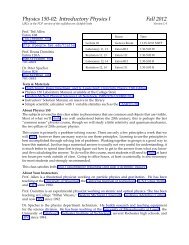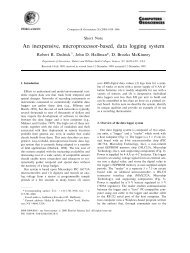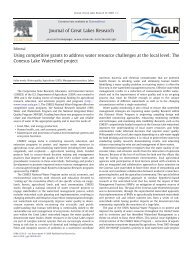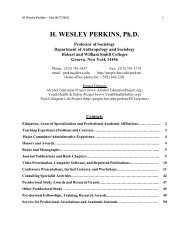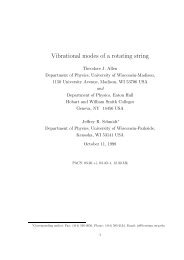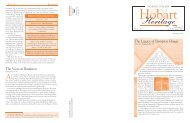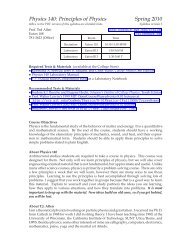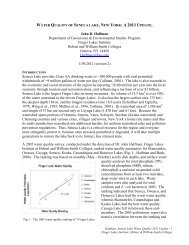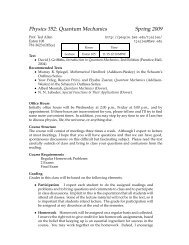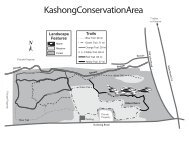Geology of New Zealand Field Trip Guidebook - ResearchGate
Geology of New Zealand Field Trip Guidebook - ResearchGate
Geology of New Zealand Field Trip Guidebook - ResearchGate
You also want an ePaper? Increase the reach of your titles
YUMPU automatically turns print PDFs into web optimized ePapers that Google loves.
West Coast Gold- Significant quantities <strong>of</strong> gold were produced in the area from Ross north<br />
to Hokitika and Greymouth in the 19th century. Virtually all <strong>of</strong> this gold recovered from the<br />
region occurred as placer deposits. Gold typically occurs as a nearly pure metal (a “native”<br />
element) in hydrothermal veins. Because gold is both very dense (specific gravity 19.3 vs.<br />
11.4 for Pb) and chemically inert, it persists through the weathering cycle and can be<br />
concentrated as a lag deposit in sands and gravels. Most <strong>of</strong> the gold in the Ross to<br />
Greymouth region was eroded by the vigorous west coast glaciers and deposited in glacial<br />
outwash, or outwash deposits reworked by stream or beach processes [Beanland, 1987 #3].<br />
These alluvial deposits are called placers. Between Greymouth and Hokitika there are a<br />
series <strong>of</strong> marine terraces that were prime gold prospecting areas. The terraces consist <strong>of</strong> a<br />
seaward facing cliff with a marine beach deposit at its base. Many <strong>of</strong> these marine terrace<br />
deposits are “blacksand leads”—lag deposits <strong>of</strong> heavy minerals washed out <strong>of</strong> the material<br />
that originally made the adjacent cliff (Suggate 1978). You are familiar with blacksand leads<br />
from Stradbroke Island. Blacksand leads on the west coast <strong>of</strong> the South Island indicated to<br />
prospectors that heavy material, including gold, had been concentrated. Prospectors used a<br />
variety <strong>of</strong> techniques to find and concentrate placer gold, including one you’re probably<br />
familiar with – panning. Mechanized dredges are used for commercial placer mining today;<br />
however, there are currently no active gold mines in this area. The terraces would be worth<br />
noting even if they did not contain gold. Between Hokitika and Greymouth there are<br />
successions <strong>of</strong> marine cliffs/terraces extending more than 11 km inland with elevations up to<br />
300 m above modern sea level (Suggate 1978). These raised terraces result from a<br />
combination <strong>of</strong> tectonic uplift and glacial/interglacial and eustatic sea level fluctuations.<br />
Time, weather and equipment permitting, we’ll try our hands at a little gold panning.<br />
West Coast Jade—The term jade applies to two different hydrothermal minerals (really to<br />
two different monomineralic rocks). The most precious form <strong>of</strong> jade, sometimes called<br />
“Imperial Jade,” is composed <strong>of</strong> the sodium aluminum silicate mineral called Jadeite, a<br />
single-chain silicate. The other more common form <strong>of</strong> jade is Nephrite jade, which is<br />
composed <strong>of</strong> a calcium, iron and magnesium double chain silicate, typically ferroactinolite.<br />
Jadeite is an example <strong>of</strong> a pyroxene, nephrite an amphibole. Both forms produce dense,<br />
green, translucent masses that are valued both for their beauty and, in the past, their utility.<br />
The latter property comes from the structure <strong>of</strong> the material. Both the pyroxene and the<br />
amphibole minerals occur in elongate crystals. In jades, these crystals are a few microns<br />
across and many microns long. They are intergrown in complex, interlocking patterns to<br />
produce a very tough and durable material. Most materials that we think <strong>of</strong> as tough are very<br />
hard, but also brittle. Jade is different. Jade is s<strong>of</strong>t enough to be relatively easily worked, but<br />
is nearly unbreakable. Because <strong>of</strong> this, Maori jade was a prized material both for carvings<br />
and for superior stone tools. In fact, the Maori had a major collection and trade network for<br />
pounamu (jade) up and down the West Coast, across Arthur’s Pass and across the Canterbury<br />
Plain to ports that took the material to settlements on the North Island. In <strong>New</strong> <strong>Zealand</strong>,<br />
nephrite is found as boulders in streams draining the Southern Alps. The location <strong>of</strong> major<br />
pounamu boulders were closely guarded secrets among Maori traders. Many <strong>of</strong> these<br />
nephrite boulders were discovered by Kiwis <strong>of</strong> European descent during the gold rush days,<br />
but in recent years supplies have dwindled and prices have risen. Hokitika remains the center<br />
<strong>of</strong> <strong>New</strong> <strong>Zealand</strong>’s jade carving industry.<br />
Stop 1: Hokitika<br />
We will stop for lunch and some free time in Hokitika. It was a booming port during the gold<br />
rush years, but now is a little tired and struggling to maintain an economy from the few<br />
26




